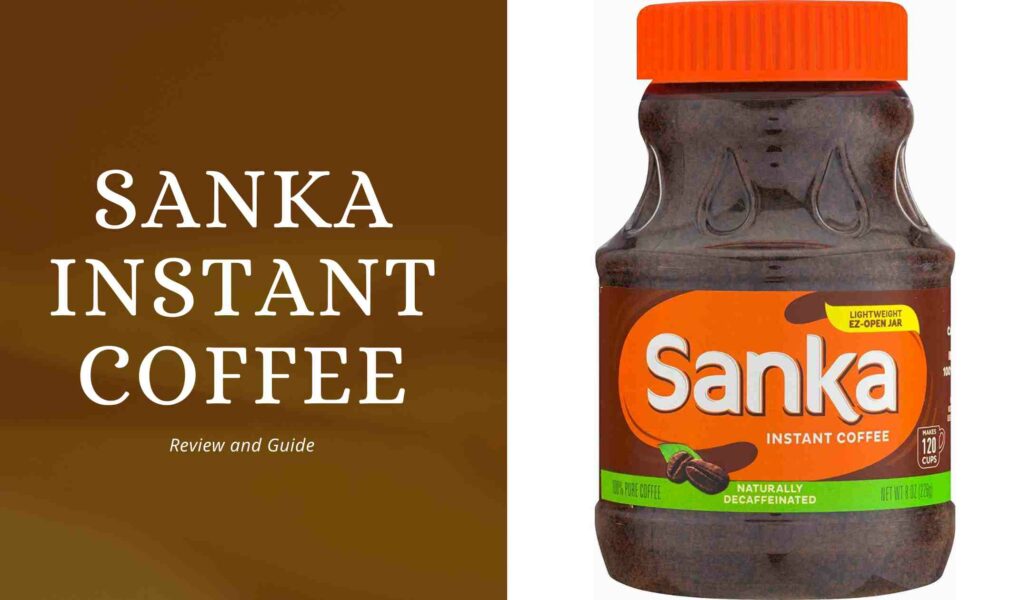If you are experienced in the instant coffee market, then you will probably have heard about Sanka instant coffee, in fact, it goes back many years, and everyone should have heard of it. But how much do you really know about the brand? What does it taste like? Where did it come from? In this article, we are going to have a look at what Sanka instant coffee is and where it came from.
You might also enjoy reading about Starbucks instant coffee.
History of Sanka Instant Coffee
Sanka is a popular, global brand of instant decaffeinated coffee. After the development of decaffeinated coffee in the early 20th century, a few brands became distributed around Europe.
After appearing in Germany and across Europe as Coffee HAG, Sanka was sold and marketed in France and the United States after the patent for Coffee HAG was sold. The name Sanka was chosen as an adaptation of the French “sans caffeine,” which means “without caffeine”.
Shortly after the European introduction, Sanka coffee was distributed in the United States in 1923 by the large food corporation General Foods, later becoming part of Kraft Foods. Sanka coffee went through various purchases and name changes, including almost disappearing entirely, but remained a premium brand of decaffeinated coffee in various countries, especially France and the U.S.
In fact, the name and orange labeling of Sanka became synonymous with decaf in the United States for much of the 20th century. Many individuals throughout the U.S. can remember the iconic orange jar of Sanka as a staple at a grandparent’s or other relative’s house.
As one of the oldest brands of decaffeinated coffee, Sanka, now produced by Maxwell House, offers a variety of products and packaging around the world. While Sanka is not as featured in physical grocery stores as it once was, it is still an easy coffee to find via various online sellers, including Amazon.
What is Sanka Instant Coffee

Sanka is a decaffeinated instant coffee with an appearance and taste very similar to other, fully caffeinated instant coffee products. Like other instant coffees, Sanka uses dehydrated coffee solids that can be combined and stirred with a hot liquid, usually water or milk, to create a hot coffee beverage. Once the instant coffee has been mixed with a hot liquid, it can be creamed, sweetened, or iced like any other cup of coffee.
Recommended” Instant coffee vs ground coffee.
Sanka Instant Coffee Review
First, it is important to note that in general, instant coffee does not have the best reputation. Instant coffee is often labeled as having a weak flavor or a stale taste. However, some drinkers do enjoy instant coffee. Also, since the preparation of instant coffee relies on being mixed with a hot liquid, the ratios can be altered to meet everyone’s strength and taste preferences.
With that being said, Sanka Decaffeinated Instant Coffee looks, tastes, and smells quite similar to other instant coffee varieties. While it is more mild than other brewed coffee, it drinks smooth and can be increasingly flavored with creams and sweeteners. The lack of caffeine does not alter the taste.
For anyone that thinks instant coffee is generally too weak, or for anyone that just craves a stronger, bolder cup of coffee, it might be helpful to adjust the ratios. Following the preparation directions on the packaging of a Sanka product will produce a mild, drinkable beverage. For stronger flavors, drinkers may want to experiment with larger quantities of instant coffee with the same amounts of liquid for a more robust brew.
The biggest downside for many coffee drinkers is that Sanka Instant coffee is decaffeinated. So, it will not provide the morning or midday pick-me-up that many coffee drinkers enjoy. However, for anyone wishing to limit their caffeine intake, this is a suitable product.
Since Sanka Instant Coffee is easy to prepare, it is an easy product to take on traveling or to keep at the workplace. Sanka is also helpful in business and commercial settings, since having decaffeinated options is a respectful gesture in many situations. Whatever the reason for trying a decaffeinated instant coffee, Sanka has a long history and reputation to back up its product.
While Sanka is historically one of the biggest names in decaf products, there is a lot of competition. Many smaller coffee roasters have introduced their own versions of instant coffee, sometimes including decaffeinated options. So, for individuals wishing to support smaller businesses or a different-tasting product, Sanka may not be the best option.
Sanka Instant Coffee Options
Like many other instant coffee products, Sanka comes in various sizes of jars, as well as boxes of pre-portioned satchels of instant coffee. While the pre-portioned options may be helpful for travel or some commercial settings, it is harder to deviate from the preparation instructions for a custom brew.
For individuals that like weaker or stronger beverages, buying the jars provides an easier way to use a more specific amount of instant coffee in each beverage. Sanka is often sold in 2oz. and 8oz. jars.
The Final Sip
Again, instant coffee products, including decaffeinated ones, may not be suitable for everyone. However, anyone wishing to enjoy a convenient, hot coffee without caffeine will certainly want to try Sanka products. Sanka instant coffee has a global reputation for producing desirable coffee products, and that has not changed over the years.




